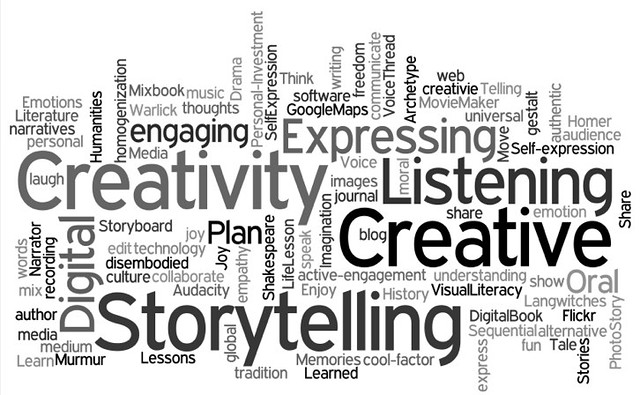Why I chose Digital Storytelling
Only one of the greatest technology tools to ever hit classrooms
 |
| https://farm5.static.flickr.com/4001/4473683746_6a158bf898_m.jpg |
The picture above says it all. Digital stories allow you to be creative, and what is more fun than being creative? Through this semester in ECI, we have learned and talked about many tools that can be used in our classrooms. One that stuck out to me and that I can see myself using in my classroom is Digital Storytelling. Digital Storytelling is using a video to tell a story, whether that is a story that you made up or a true story. It brings the story to life, letting you add characters, and especially voice to the story, which can make the story much more engaging and entertaining. In my opinion, Digital Storytelling can provide teachers with a fun, educational teaching tool that can provide life to their lessons. Digital Storytelling fits into my concept of a 21st century classroom because in the future, I see students writing less papers and creating more digital stories because they are more engaging and with the technology takeover, why not use it?
 |
| https://c2.staticflickr.com/4/3928/15236841078_313571e894_h.jpg |
This tool of Digital Storytelling can provide the students with many opportunities and advantages, such creativity, voice, engagement, and fun (which never hurt anybody!). Digital Storytelling can also provide teachers with opportunities, such as enhancing current lessons and making those concepts that may be confusing a little bit more understandable. This is all explained more at this website, https://c2.staticflickr.com/4/3928/15236841078_313571e894_h.jpg, where Dr. Robin goes into more detail about digital storytelling for teachers and students.
There are many reasons why Digital Storytelling is my favorite tool that we have talked about and experimented with in our class. For one, I love that it incorporates a ton of tools into one. With digital storytelling, you have to be comfortable with movie maker or iMovie, in order to create the video. You have to be comfortable with researching and finding pictures online. For some cases, like we did in ECI, you can use StoryBoardThat, which is another Web 2.0 tool, to outline your story and figure out what you are going to create your story about. With all of this being said. it definitely is neat to see how Digital Storytelling links all of these tools into one.
Another reason why I prefer Digital Storytelling is that they aren't hard to make. It doesn't take a genius to create a digital story, it just takes practice and determination. In the following video, second and third grade classes learned about digital stories and how to create their own.
https://www.youtube.com/watch?v=rUZXBc6yRhU
I plan on teaching Kindergarten or First Grade after graduating. I do think it would be challenging for these grade levels to create their own digital story by themselves. It would be a good idea for them to work as a group and maybe work and collaborate to create a digital story. However for these grade levels, I would make my own digital stories or find stories to show to my students. This would keep the students engaged and more willing to pay attention and learn. If I were to teach older grade levels, such as third, fourth, or fifth grade, I would give them an assignment to create their own digital story. The video below is an example of what I would be looking for a first grade student.
https://www.youtube.com/watch?v=Tau-SmU2xRs





